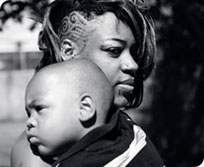In Transition: A better future for youth leaving foster care
Child Welfare Watch Volumes 19 & 20, Winter 2010/2011 (PDF)
Last year, more than 1,100 New Yorkers aged 18 or older left the city's foster care system. A few were enrolled in college. Others found steady jobs and affordable places to live. But many more were on the insecure fringes of the economy, without stable housing or income.
There are fewer children in foster care than there were 10 years ago, so fewer are leaving foster care each year. Yet despite a decade-long effort of innovators, government officials and philanthropists, the rate at which they age out of the system and into extreme poverty appears to be at least as high as it was then.
This special double edition of Child Welfare Watch reports that homelessness and severe economic hardship are widespread for young people aging out of New York City foster care. Its findings include:
- 15 percent of young men and women who became adults in New York City foster care entered homeless shelters within two years of leaving the system, half of them with children of their own, according to an unpublished city review.
- More than half of those young adults are mothers, entering shelters with children of their own.
- New, innovative housing support services for young men and women can serve only a small fraction of those who need them, even as other, long-established housing programs have been eliminated or sharply reduced.
- The number of young adults in city homeless shelters has increased nearly 71 percent since 2002, from 18,770 to 32,277.
- Family stabilization services intended to prevent placement of children in foster care are being eroded by budget cuts. The total number of children served by preventive programs declined 23 percent between September 2009 and September 2010.
Public officials in New York have reshaped foster care in hopes of promoting strong relationships with helpful adults and better preparation for adulthood. Many of these changes have proven valuable, yet the situation remains troubling.
ALSO IN THE REPORT:
- Recommendations and Solutions
- Crisis in Family Services
- Aging Out of Foster Care With Babies of Their Own: Young moms face tough odds
- Looking for Work: For former foster care children, the recession hits hard
- Learning to Be a Mom: Nurses help new mothers bond with their babies
- A Home for Five More Years:Creating a solution to homelessness for young men and women
- Housing That Works: Powerful lessons from supported housing
The 36-page report includes an investigation into the high-stakes challenges of young women who leave foster care with children of their own. It also documents lessons learned from a recent city experiment in supportive housing for high-need, high-risk young adults.
In addition, the report offers a set of policy recommendations informed by the research and drafted by a panel of practitioners, experts, parents, young people and others, aimed at helping policymakers better prepare adolescents in their care for successful, independent adulthood. These include:
- The city must create enforceable standards and adequate finding for foster care agencies to ensure that young people are connected to meaningful assistance even after leaving foster care.
- The mayor, City Council and the Administration for Children's Services (ACS) should provide funds to hire current and former foster youth as peer advocates in nonprofit agencies and government.
- ACS should take new steps to stabilize housing for young women before and after childbirth.
- Foster care agencies and ACS should make school attendance and graduation a top priority for teens in foster careâ€, including teen parents.
- The state's Office of Mental Health must create better options for young adults with mental health challenges.
httpv://www.youtube.com/watch?v=XPJmNB_daHE&feature=player_embedded#!
Christopher Guzman, 22, is one of 200 residents in a new supportive housing program for young adults leaving foster care with no place to go. Above, watch a tour of Guzman's new home and hear, in his own words, about his life in transition.
